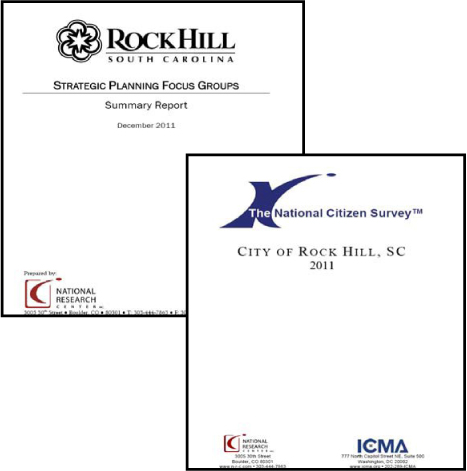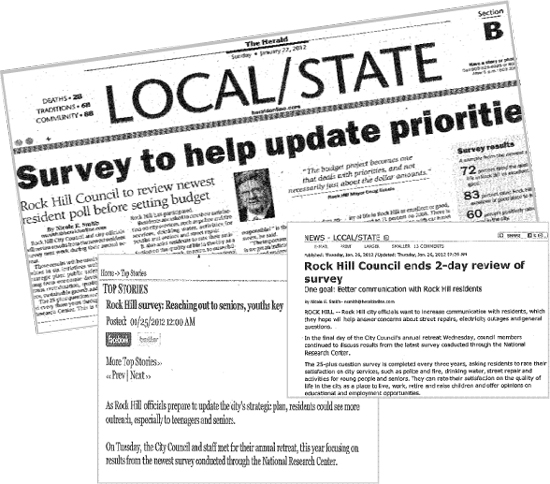Appendix O

CPM CASE STUDY
Engaging citizens in Rock Hill, South Carolina’s strategic planning
By Kira Hasbargen
Since 2003, the city of Rock Hill has participated in The National Citizen Survey (The NCS ), a uniform survey tool used to assess resident satisfaction with community amenities and government service provision. While the city has always found the survey results to be useful, for FY 2012 the city decided to use the survey data more deliberately so the results would be more meaningfully applied to the strategic plan.
CASE PROFILE
Rock Hill, SC
Population:
66,154
Square Miles:
36.6
Median household income:
$39,950
Form of government:
Council manager
Going beyond the survey numbers
In August 2011, city leadership decided supplementing The NCS™ data with qualitative data would both complement and enhance the city’s survey results, making it more effective in the strategic planning process. The city’s first step was to draft a timeline to align survey distribution, review, and analysis with citizen focus groups. The city manager’s office led efforts in developing an appropriate implementation schedule and contracted with the local university’s political science department to manage the focus group recruitment process. The university routinely conducts regional polls through the university research center and had all the necessary resources – including trained staff and a computer aided telephone system – to contact potential focus group participants. The National Research Center, Inc. (The NRC), a research firm specializing in performance measurement and evaluation, was brought in to facilitate three citizen focus groups.
The focus groups
The goals of the focus groups were to obtain qualitative data from the opinions of residents and better understand their priorities for the community to help shape the city’s strategic plan. In conjunction with city staff, the NRC developed a focus group script with questions that were asked in all three discussions. The commonality in the script enabled a deeper understanding of residents’ opinions. The script focused on participants’ current perspectives about Rock Hill, their visions for the community in the future, and their opinions about city goals.
The focus groups were held at a city facility for which no fee was required. City staff was not present during the focus groups. All groups were digitally audio-recorded and transcribed for analysis purposes. The NRC identified key statements and general themes in a focus group summary report.
Sharing and using the focus group data
Committed to transparency, city leadership shared the summary report, full survey results, and focus group transcripts with elected officials and senior management, framing the material as guiding documents for the city council strategic planning retreat.
Not only was the local newspaper provided the full survey results in advance of the retreat, the media was also invited to discuss the results with the city manager and public affairs staff.
During the two-day retreat, the NRC executive director reviewed both the survey results and focus group feedback, and a city staff representative offered highlights on department performance at meeting established performance benchmarks. This format allowed for meaningful comparisons of actual performance to public satisfaction and perception. For example, safety perception ratings were compared to actual crime data trends. The city’s survey results showed that the perception of being very or somewhat safe from violent crimes was at an all-time high; this perception trended with actual crime data that showed violent crime rates at historic lows. Focus group feedback and survey results also revealed that the perception of safety in the downtown area after dark continued to receive some of the lowest marks, despite the downtown area having very low crime rates. Consequently, one of the tasks developed during the retreat required the city to hold focus groups to delve deeper into how the city could improve the perception of safety in the downtown area.
The lessons learned
By coupling citizen survey results with qualitative focus groups, Rock Hill found it was important to:
- Reflect on the data: Delve deeper into the data themselves. How do the survey results compare to actual citizen comments? What are the trends in performance? How do you compare to your peers?
- Discuss the data: Create structured opportunities such as a retreat, community open house, or staff meeting to discuss the context of results, the results themselves, and next steps.
- Share the data: Commit to sharing the results with staff, elected officials, residents, and the media. Transparency helps to promote an insightful and rich discussion that not only helps the local government respond to citizen needs, but also conveys a commitment to the community.

